Chapter 2 Hardware Overview
This chapter provides an overview of the following NFS servers and expansion units:
-
Sun Enterprise 1 system
-
Sun Enterprise 2 system
-
SPARCserver 20 system
-
Sun Enterprise 150 system
-
Sun Enterprise 250 system
-
Sun Enterprise 450 system
-
Sun Enterprise 4000, 5000, and 6000 systems
-
Sun Enterprise 3500, 4500, 5500, and 6500 systems
-
SPARCserver 1000 or SPARCserver 1000E system
-
SPARCcenter 2000 or SPARCserver 2000E system
-
Netra NFS Server system
-
SPARCstorage Array subsystem
-
Sun StorEdge A1000 RAID Disk Array
-
Sun StorEdge A3000 subsystem
-
Sun StorEdge A5000 subsystem
-
Sun StorEdge A7000 Intelligent Storage Server
-
SPARCstorage MultiPack enclosure
-
SPARCstorage UniPack enclosure
NFS File Servers
This section provides a hardware overview of Sun NFS servers. Table 2-1 illustrates the conditions under which a particular NFS file server will meet your needs. This table is arranged by first presenting the Netra NFS Server, a dedicated NFS server. Next, the table presents high capacity enterprise servers followed by workgroup servers. Workgroup servers are dedicated to a group, department, or small organization that shares common resources or tasks. Workgroup servers usually provide a specific function such as an NFS file server.
Table 2-1 NFS Server Comparison Table|
Server |
Maximum Specifications |
Positioning |
Key Advantages |
|---|---|---|---|
|
Netra NFS Server |
--100 NFS clients --24 Gbytes of internal disk storage (48 Gbytes with 4 Gbyte disk drives) --2 subnets with Fast Ethernet (100 BaseT), Token Ring, FDDI --9 subnets with 10BaseT Ethernet |
Dedicated NFS server supporting both workgroup and department needs |
Industry leading NFS price/performance with RAID 5; Fast response times; easy to administer with HTML user interface; highly reliable with internal UPS and RAID 5; includes PC-NFS server software; exclusively supports NFS applications; RAID 5 and single file system is preconfigured |
|
Sun Enterprise 6000 |
--At least 600 NFS clients --189 Gbytes of disk storage (system enclosure only) --More than 20 subnets per system --Ethernet, optional FDDI, SunATM, and Token Ring |
Most scalable and expandable Sun server |
Handles a minimum of 14,000 ops/second, which is equivalent to 140,000 PC clients; handles arbitrary NFS client loads |
|
Sun Enterprise 5000 |
--At least 400 NFS clients --233 Gbytes of disk storage (system enclosure only) --More than 20 subnets per system --Ethernet, optional FDDI, SunATM, and Token Ring |
Data center server system |
Delivers high performance and high availability for enterprise wide applications supporting thousands of users; able to handle arbitrary NFS client loads |
|
Sun Enterprise 4000 |
--At least 400 NFS clients --168 Gbytes of disk storage (system enclosure only) --More than 20 subnets per system --Ethernet, optional FDDI, SunATM, and Token Ring |
Compact yet highly expandable system |
Delivers high performance scalability for department applications in a distributed network computing environment; handles arbitrary NFS client loads |
|
Sun Enterprise 3000 |
--At least 300 NFS clients --42 Gbytes of disk storage (system enclosure only) --More than 20 subnets per system -- Ethernet, optional FDDI, SunATM, and Token Ring |
Affordable departmental server |
Applications support up to hundreds of users in an office environments; handles arbitrary NFS client loads |
|
Sun Enterprise 6500 |
--382 Gbytes internal storage (system cabinet only) --Greater than 10 Terabytes of total disk storage --30 CPUs and 30 Gbytes of memory |
High end datacenter server |
Handles arbitrary NFS client loads; Dynamic Reconfiguration, Alternate Pathing, and CPU power control |
|
Sun Enterprise 5500 |
--509 Gbytes of internal storage (system cabinet only) --Greater than 6 Terabytes of maximum disk storage --14 CPUs and 14 Gbytes of memory |
Entry level datacenter server |
Handles arbitrary NFS client loads; Dynamic Reconfiguration, Alternate Pathing, and CPU power control |
|
Sun Enterprise 4500 |
--33.6 Gbytes of internal storage (system only) --Greater than 4 Terabytes of total disk storage --14 CPUs and 14 Gbytes of memory |
High end departmental server |
Handles arbitrary NFS client loads; Dynamic Reconfiguration, Alternate Pathing, and CPU power control |
|
Sun Enterprise 3500 |
--72.8 Gbytes of internal storage (system only) --Greater than 2 Terabytes of total disk storage --8 CPUs and up to 8 Gbytes of memory |
Entry level departmental server |
Handles arbitrary NFS client loads; Dynamic Reconfiguration, Alternate Pathing, and CPU power control |
|
SPARCcenter 2000 or 2000E |
--500 NFS clients --36 subnets --731 Gbytes of storage --Ethernet, FDDI, SunATM, and Token Ring |
Highest capacity; multipurpose enterprise server (the total solution for an entire company) |
Centralized administrationmaximum headroom for growth; multiprocessor, I/O, and network performance scalability |
|
SPARCserver 1000 or 1000E |
--300 NFS clients --12 subnets --395 Gbytes of storage --Ethernet, FDDI, SunATM, and Token Ring |
High capacitymultipurpose workgroup server |
Excellent capacity performance; multipurpose server (NFS, compute, database), affordable, scalable, integrated packaging |
|
Sun Enterprise 450 |
--Used in environments that require large amounts of disk storage with fast or multiple I/O channels to clients or to the network |
Mid-range server |
Supports RAID 1 (disk mirroring), RAID 3 (striping data and parity across drive groups), and RAID 5 (hot spares for FC-AL disks) |
|
Sun Enterprise 250 Server |
--Up to 54 Gbytes of disk storage, dual CPU processor, and fast PCI I/O channels |
Mid-range server |
Supports RAID 0 (disk striping), RAID 1 (disk mirroring), and RAID 5 (hot spares); automated hardware failure notification; hot sparing support |
|
Sun Enterprise 150 Server |
--Internal disk array with up to twelve hot-plugable disks providing 48 Gbytes of disk capacity (based on 4 Gbyte disks) |
High end workgroup server |
Supports RAID 0 (disk striping) RAID 1 (disk mirroring) and RAID 5 (hot spares); high level of I/O throughput and capacity; significant expansion capabilities; advanced I/O and networking |
|
Sun Enterprise 2 |
--At least 350-400 NFS clients --67 Gbytes of disk storage (4 Gbytes in the system and 63 Gbytes in the SPARCstorage Array) --4 subnets --Ethernet, optional FDDI and SunATM |
High performance multiprocessing server for mid to large size workgroups |
High throughput for multiprocessing; high application performance; efficient design and process handling |
|
Sun Enterprise 1 |
--200-220 NFS clients --147 Gbytes of storage -- 4 subnets --Ethernet, optional FDDI and SunATM |
High capacity; medium to large workgroup server (50 to 100 users) |
Excellent performing uniprocessor workgroup server that simplifies administration and lowers costs |
|
SPARCserver 20 |
--125 NFS clients --138 Gbytes of storage --4 subnets --Ethernet, FDDI, SunATM, and Token Ring |
Low cost; multipurpose workgroup server PC LAN server |
Low cost, powerful, flexible, and easily redeployed |
Dedicated NFS Servers
This section presents an overview of the Netra NFS Server system.
Netra NFS Server System
The Netra NFS Server system provides an easily managed, highly reliable, highly tuned dedicated NFS server. It is built exclusively to support NFS applications; Solaris software environment applications are not supported. This Netra NFS server provides superior NFS operations performance over general purpose servers.
The key benefits of this Netra NFS server include:
-
Easy installation (preconfigured system)
-
Easy HTML management interface with the LCD system status and input panel
-
Factory preconfigured RAID-5 disks
-
Dedicated, simplified operation set
-
Tuned for NFS performance
-
System reliability (UPS for graceful shutdown on power failure)
-
Uninterruptable power supply
This server meets the demands of high speed network environments. Because this server delivers high performance for NFS operations, it is most often installed in departments and workgroups where data access requirements are high and other servers are available for running applications and system management software (see Figure 2-1).
Figure 2-1 Environments Supported by the Netra NFS Server

As Figure 2-1 shows, the Netra NFS Server system supports both workgroup and department needs.
Netra NFSServer Software Support
The easy to use customized Netra NFS SmartServe(TM) software, which is focused exclusively on NFS applications, is tuned for NFS performance and is easy to administer. The software has the following features:
-
Modified Solaris operating environment (dedicated and optimized for NFS)
-
SNMP agent
-
Single file system and RAID 5 preconfigured
-
Backup software for online backups
-
Support for NFS Version 2 and NFS Version 3
-
Disk management support (RAID level 5 for storage management)
-
Failure management and recovery
-
System performance tuning (stable memory and NFS Smart Cache)
-
PCNFSD (to use with NFS on PCs)
Netra NFS Server Hardware Overview
This server is based on the Ultra 1 processor board, which is designed to deliver balanced system performance. With twelve slots of data disks, the data disk capacity of this server is 24 Gbytes (48 Gbytes with 4 Gbyte disk drives). The disk drives are hot plugable. A 10BaseT Ethernet controller is built onboard.
One of the three SBus slots are used for ISP controllers. The second SBus slot contains a 100BaseT network card. The third SBus slot is available for additional network interfaces.
This system comes in two options: tower and rack-ready. Four rack-ready systems can be installed in standard Sun racks. The system also has a standard 3.5-inch diskette drive and a 644 Mbyte capacity CD-ROM drive. The eight SIMM slots can store up to 512 Mbytes of RAM.
Enterprise Servers
Sun has a range of enterprise servers. This section discusses the following enterprise servers:
-
Sun Enterprise 4x00, 5x00, and 6x00 servers
-
SPARCcenter 2000/2000E servers
-
SPARCserver 1000/1000E servers
Sun Enterprise 4000, 5000, and 6000 Systems
The Sun Enterprise 6000 server system, the Sun Enterprise 5000 server system and the Sun Enterprise 4000 server system are available in two enclosures (see Figure 2-2):
-
Enterprise 6000 or 5000 is a 56-inch cabinet containing either a 16-slot or 8-slot card cage.
-
Enterprise 4000 is a stand-alone enclosure containing an 8-slot card cage.
Figure 2-2 Sun Enterprise 6000 and 5000 Server Cabinet System and Sun Enterprise 4000 Stand-alone System

The same CPU/memory board, I/O boards, disk board, processor modules, memory SIMMs, power modules, and cooling modules are used in all enclosures.
The minimum configuration for the Sun Enterprise 4000, 5000, and 6000 is:
-
16-slot or 8-slot card cage
-
Modular power supply
-
Fan tray (cabinet servers) or fan box (standalone server)
-
Clock board
-
CPU/memory board
-
I/O board
-
Peripheral power supply
-
AC distribution unit
-
SCSI receptacle for removable media, including CD-ROM
Sun Enterprise systems have extensive error detection mechanisms, and an Automatic System Reconfiguration (ASR) feature that enables the system to be rebooted with failed components (such as CPUs, memory, or I/O) disabled. When an error is detected, the system is reconfigured so that the board containing the failed components is placed in low power mode and is no longer accessible.
The hot-plugable feature inserts a new board into a powered up system, despite being "live," or being supplied with electrical power. Once a working board is added to a powered on system with the hot-plugable feature, the Solaris 2.5.1 or 2.6 software environments will not use the new board until the system is rebooted. The systems also support hot-plugable disk drives and redundant, hot-plugable power and cooling units.
High speed networking is supported by integrated 10 or 100 Mb Ethernet and optional ATM interface.
The systems support remote control administration, which enables remote rebooting and power cycling.
The system monitor for these servers is Solstice(TM) SyMON(TM), a system performance tool that you can use to:
-
Monitor the performance of a large server with multiple processors, I/O, and disks.
-
Optimize the configuration and throughput of the server.
-
Identify hardware and software failures quickly. Failures range from major failures (CPU crash), to minor failures (slow cooling fan). Solstice SyMON identifies the component or software and its location.
-
Monitor hardware performance to detect incipient hardware failure (soft read errors on a disk).
Sun Enterprise 3500, 4500, 5500, and 6500 Systems
The 3500-6500 mid range server line uses the 336 MHz UltraSPARC(TM) processor and the 84MHz to 100 MHz interconnect called the Sun Gigaplane(TM) system bus. This server family includes hot-pluggable disk drives, processors, power supplies and cooling. Dynamic Reconfiguration and Alternate Pathing software, which lets you add, remove, or replace system resources while maintaining application availability, is a new feature of these servers. The server family also has CPU power control, a new feature.
The Sun(TM) Enterprise(TM)3500 server, designed to be an entry-level departmental server, is contained in a tower/deskside enclosure. It has five system slots that can be used for either CPU/memory boards or I/O boards and contains up to eight CPUs. It has up to 8 Gbytes of memory, 72.8 GBytes of internal disk storage, and can provide greater than 2 Terabytes of maximum total disk storage. The system also includes one CD-ROM drive and an optional tape drive. It includes disk bays for eight dual-ported FC-AL disk drives.
The Sun Enterprise 4500 server is housed in a tabletop enclosure and has eight system slots providing capacity for up to 14 CPUs. It is designed to be a high end departmental server and has up to 14 Gbytes of memory. The server provides 33.6 Gbytes of interal storage and can provide up to 4 Terabytes of maximum total disk storage. The server also contains one tape drive.
The Sun Enterprise 5500 server, designed to be an entry-level datacenter server, also has eight system slots providing up to 14 CPUs but the enclosure is a 68-inch cabinet. It contains up to 14 Gbytes of memory. It provides up to 509 Gbytes of internal storage and has the capability to provide greater than 6 Terabytes of maximum total disk storage. The server also contains a tape library.
The Sun Enterprise 6500 server, a high-end datacenter server, also is housed in a 68-inch cabinet. It has 16 system slots and can contain up to 30 CPUs and 30 Gbytes of memory. The server provides 382 Gbytes of internal storage and can provide greater than 10 Terabytes of maximum total disk storage. The server also contains a tape library. The system rack provides support for multiple internal disk subsystems and tape options.
Figure 2-3 Front View of the Sun Enterprise 6500, 5500, and 4500 Servers

SPARCcenter 2000 and SPARCcenter 2000E Systems
The SPARCcenter 2000 and the SPARCcenter 2000E systems, which were introduced in 1992, provide the computing solution for a company. As such, the SPARCcenter 2000 system and the SPARCcenter 2000E system are multifunctional network NFS file servers. They support less than 500 NFS clients and have the flexibility required for dedicated or multifunctional application environments.
The SPARCcenter 2000 system and the SPARCcenter 2000E system provide scalability and extensive expansion in these areas:
-
CPU processor power
-
Memory capability
-
I/O connectivity
They meet the following requirements:
-
High capacity I/O requirements of corporate data centers
-
Computationally intensive demands of other organizations
The heart of the SPARCcenter 2000 system or the SPARCcenter 2000E system is a high-speed packet-switched bus complex that provides very high data transfer bandwidth. The backplane supports two distinct XDBuses operating in parallel.
The SPARCcenter 2000 system or the SPARCcenter 2000E system use up to twenty SuperSPARCTM modules in a shared-memory symmetric multiprocessing configuration, meeting most performance needs. You can expand or upgrade the processing capability by adding SuperSPARC modules.
Main memory is configured in multiple logical units that are installed in the bus complex.
The I/O is expandable. For example, you can configure up to 40 SBus slots on 10 independent buses. The large I/O capacity and configurability makes the SPARCcenter 2000 system or the SPARCcenter 2000E system suitable for very large applications.
The system monitor for this server is Solstice SyMON.
SPARCserver 1000 and the SPARCserver 1000E System Features
The SPARCserver 1000 and the SPARCserver 1000E systems have the following features:
-
Up to four system boards can be installed
-
Up to eight SuperSPARC processors (two per system board) can be installed
-
Up to 2 Gbytes of main memory (using 32 Mbyte SIMMs) can be installed
-
Up to 16.8 Gbytes of internal storage
-
50 MHz system clock speed in the SPARCserver 1000E system (40 MHz in the SPARCserver 1000 system)
-
25 MHz SBus speed in the SPARCserver 1000E system (20 MHz in the SPARCserver 1000 system)
-
When connected to 12 SPARCstorage Array subsystems, the SPARCserver 1000 or 1000E systems provide up to 756 Gbytes of external storage
-
Up to 12 SBus slots
-
Onboard SCSI-2 port and twisted pair Ethernet on each system board
-
Internal 5 Gbyte 4mm tape drive (or 10 Gbyte 8mm tape drive)
-
Internal CD-ROM drive
-
NVRAM-NVSIMM Prestoserve NFS accelerator (optional)
Workgroup Servers
This section presents an overview of the following workgroup servers:
-
Sun Enterprise 150 server system
-
Sun Enterprise 250 serversystem
-
Sun Enterprise 450 serversystem
-
Sun Enterprise 2 server system
-
Sun Enterprise 1 server system
-
SPARCserver 20 server system
The highest capacity workgroup servers are presented first.
Sun Enterprise 150 Server System
The Sun Enterprise 150 server system is a tower workgroup server based on the 167 MHz UltraSPARC(TM) microprocessor. It has the following features:
-
Autosensing 10/100 Mbps Fast Ethernet
-
10 Mbps Ethernet
-
20 Mbyte/second Fast/Wide SCSI-2 peripheral interface
-
ECC-protected memory
-
Internal disk array with up to twelve hot-plugable disks supporting RAID 0 (disk striping), RAID 1 (disk mirroring), and RAID 5 (hot spares) providing 48 Gbytes of disk capacity (based on 4 Gbyte disk drives)
-
1.44 Mbyte diskette drive
-
644 Mbyte CD-ROM drive
The Sun Enterprise 150 server system is ideal for an NFS server because it is a high-end workgroup server with high I/O performance and fast system throughput. Figure 2-4 shows a front view of the server.
Figure 2-4 Sun Enterprise 150 Front View

For additional disk storage, you can attach either the Sun StorEdge UniPack or the Sun StorEdge MultiPack to the server. If you need greater amounts of disk storage, use the SPARCstorage Array to the server. For a backup device, use the SPARCstorage Library, which olds ten cartridges in a removable magazine for an average total capacity of 140 Mbytes.
Sun Enterprise 250 System
The Sun Enterprise 250 system server is a mid-range server with up to 54 Gbytes of disk storage, dual CPU processors, and fast PCI I/O channels.
Software features are:
-
RAID 0 (disk striping), RAID 1 (disk mirroring), and RAID 5 (hot spares)
-
System performance and configuration monitors
-
Automated hardware failure notification
-
Error and panic logging
-
Temperature sensing and fan control
-
Backup power supply failure detection
-
Hot sparing support
-
Automatic fault detection, response, and recovery
-
Logging file systems
-
Secure remote system monitoring feature for geographically distributed or physically inaccessible systems
Hardware features are:
-
Four PCI slots supporting up to four full size PCI cards (three regular PCI slots and one enhanced PCI slot)
-
Up to sixteen SIMM slots, which support 16, 32, 64, or 128 Mbyte SIMMs totaling up to 2 Gbytes of memory capacity
-
10/100 Mbit Ethernet
-
20 Mbyte/second Fast Wide SCSI
-
Up to two CPU modules (UltraSPARC-II)
-
Up to six 1.6-inch high or 1-inch high UltraSCSI disks
-
1.44 Mbyte diskette drive
-
644 Mbyte CD-ROM drive
-
Two 5 1/4-inch x 1.6-inch removable media bays
-
Two high speed synchronous/asynchronous serial ports
-
Up to two redundant hot swapable power supplies
-
Module to provide remote system monitoring capability
-
Supports rack mounting allowing the system to integrate easily into a computer room environment
Figure 2-5shows a front view of the Sun Enterprise 250 system.
Figure 2-5 Sun Enterprise 250 Front View
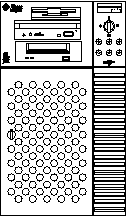
Sun Enterprise 450 System
The Sun Enterprise 450 system server, based on the UltraSPARC-II(TM) processor, is designed for mid-range server markets that require large amounts of local disk storage with fast or multiple I/O channels to clients or to the network.
Software features are:
-
Support for RAID 1 (disk mirroring), RAID 3 (striping data and parity across drive groups) and RAID 5 (hot spares for FC-AL disk drives)
-
System performance and configuration monitors
-
Automated hardware failure notification
-
Error and panic logging
-
Temperature sensing and fan control
-
Backup power supply failure detection
-
Hot sparing support
-
Automatic fault detection, response, and recovery
-
Logging file systems
Hardware features are:
-
10 PCI slots supporting up to 10 full size PCI cards (seven regular PCI slots and three enhanced PCI slots)
-
Up to sixteen SIMM slots, which support 32, 64, 128 or 256 Mbyte SIMMs totalling up to 4 Gbytes of memory capacity
-
10/100 Mbit Ethernet
-
20 Mbyte/second Fast Wide SCSI
-
Up to four CPU modules (UltraSPARC-II)
-
Up to twenty hot swappable FC-AL disks and up to two 1.6-inch high SCSI disks that provide up to 84 Gbytes internal storage
-
Up to 6 Terabytes of external disk storage
-
1.44 Mbyte diskette drive
-
644 Mbyte CD-ROM drive
-
Two 5 1/4-inch bays for optional tape backup
-
Two high speed synchronous/asynchronous serial ports
-
Up to three redundant hot swapable power supplies, which can be added one at a time to improve reliability and provide growth as needed
-
Supports rack mounting allowing the system to integrate easily into a computer room environment
Figure 2-6 Front View of the Sun Enterprise 450 Server

You can attach up to two external tape devices or a single size or twelve drive Sun StorEdge MuliPack to the SCSI port. You can attach additional tape or disk devices by installing PCI host adapter cards. If you require large amounts of disk storage, you can also attach the Sun StorEdge A3000 subsystem to the system that provides a reduntant array of inexpensive disks (RAID).
Sun Enterprise 1 and 2 Systems
The Sun Enterprise 1 system is the first member of a new class of workstations based on the UltraSPARC-I processor and is designed to deliver balanced system performance.
The Sun Enterprise 1 system can be used as a high capacity NFS server for medium to large workgroups (50 to 100 users). It is designed for reliability, availability, and serviceability. It enables easy access to replace disk drives, SIMMs, and graphics cards.
The Sun Enterprise 2 system is a multiprocessor system based on the UltraSPARC-I processor. It is standard with Fast/Wide SCSI and Fast Ethernet, which enables the data throughput capability of this system to include the disk I/O and the network traffic. The system also has a 64-bit SBus running at 25 MHz giving maximum SBus throughput.
The Sun Enterprise 2 system can be used as an NFS server for mid- to large- sized workgroups.
The Ultra SPARC CPU is matched by a very high performance crossbar-switched interconnect that can move data at peak rates of 1.3 Gbytes/second. This interconnect, the Ultra Port Architecture (UPA), is the key to providing the greatly enhanced memory bandwidth. Both the Sun Enterprise 1 and 2 systems have a 64-bit SBus running at 25 MHz giving maximum SBus throughput.
The architecture was designed to be fully compatible with previous generations of workstations so that all Solaris operating environment applications can run unchanged.
Figure 2-7 shows a front view of the Sun Enterprise 1 system.
Figure 2-7 Sun Enterprise 1 Front View
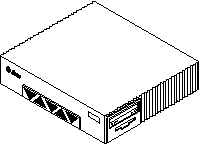
SPARCserver 20 System
The SPARCserver 20 system, introduced in 1994, is designed to be a workgroup NFS file server or a database server in an office environment. It is based on the same MBus and SBus technologies as the SPARCserver 10 system. Performance is increased over the SPARCserver 10 by using faster MBus and SBus technology, and faster SPARC modules. The SPARCserver 20 system has increased computing and network performance.
The SPARCserver 20 system is available in three uniprocessor configurations and three multiprocessor configurations.
The uniprocessor configurations are:
-
Model 50--50 MHz SuperSPARC processor
-
Model 51--50 MHz SuperSPARC processor and 1 Mbyte SuperCache
-
Model 61--60 MHz SuperSPARC processor and 1 Mbyte SuperCache
-
Model 71--75 MHz SuperSPARC processor and 1 Mbyte SuperCache
-
Model 151--one 150 MHz HyperSPARC processor and 0.5 Mbyte external cache
The multiprocessor configurations are:
-
Model 502MP--two 50 MHz SuperSPARC processors
-
Model 514MP--four 50 MHz SuperSPARC processors and 1 Mbyte SuperCache
-
Model 612MP--two 60 MHz SuperSPARC processors and 1 Mbyte SuperCache
-
Model 712--two 75 MHz SuperSPARC processors and 1 Mbyte SuperCache
-
Model 152MP--two 150 MHz HyperSPARC processors and 0.5 Mbyte of external cache
Figure 2-8 shows the front view of the SPARCserver 20 system.
Figure 2-8 SPARCserver 20 System Front View
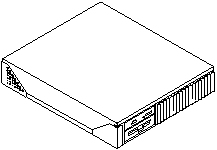
SPARCserver 20 System Features
The SPARCserver 20 system features include:
-
More than 2 Gbytes of internal hard disk storage (two 1.05 Gbyte disk drives)
-
Up to 126 Gbytes of disk storage in the SPARCstorage Array (Model 101) subsystems when directly connected to four SPARCstorage Array subsystems
-
1.44 Mbyte diskette drive (optional)
-
644 Mbyte CD-ROM drive (optional)
-
Two serial ports, one parallel port
-
Twisted-pair Ethernet
-
Up to 512 Mbytes of memory (60 ns SIMMs)
-
AUI Ethernet (optional) (can have up to 9 Ethernet networks)
-
SBus or NVRAM-NVSIMM Prestoserve NFS accelerator (optional)
Disk Expansion Units
This section describes an overview of the following disk expansion units:
-
SPARCstorage ArrayTM subsystem
-
Sun StorEdge A1000 RAID system
-
Sun StorEdge A3000 subsystem
-
Sun StorEdge A5000 subsystem
-
Sun StorEdge A7000 Intelligent Storage Server
-
Sun StorEdge MultiPackTM
-
Sun StorEdge UniPackTM
SPARCstorage Array Subsystem
To expand your disk storage, consider the SPARCstorage Array subsystem. This disk array is a high-performance and high-capacity companion unit for the Sun Enterprise 4000, 5000, or 6000 systems, SPARCcenter 2000 or 2000E, SPARCserver 1000 or 1000E, Sun Enterprise 150 system, Sun Enterprise 2 system, and the SPARCserver 20 system.
The Model 101 uses 1.05 Gbyte single connector 3.5-inch disk drives. Each disk array contains three drive trays. Each drive tray supports up to ten 3.5-inch single-connector SCSI disk drives. All disk drive SCSI addresses are hardwired. The position of the disk drive in the drive tray automatically sets the SCSI addresses. Each disk array uses six internal fast, wide SCSI buses. Each drive tray contains two SCSI buses that support five disk drives for each SCSI bus.
Figure 2-9 shows a front view of the SPARCstorage Array subsystem.
Figure 2-9 Front View of the SPARCstorage Array Subsystem
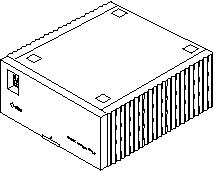
Figure 2-10 shows how you can connect the SPARCstorage Array subsystem to your NFS server.
Figure 2-10 SPARCstorage Array Subsystem Installation Options
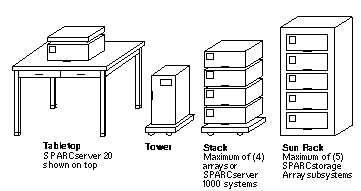
The SPARCstorage Array subsystem uses RAID (Redundant Array of Inexpensive Disks) technology. RAID 0 stripes data without parity, RAID 1 does disk mirroring, RAID 0+1 does mirroring optimized stripes, and RAID 5 does striping data with parity.
Within the disk array, independent disks plus RAID levels 5, 1, 0, 0+1 are available at the same time so you can easily match data layouts to meet the specific requirements for capacity, performance, high availability, and cost.
If any disk in a RAID-5, 1, or 0+1 group fails, an optional hot spare (if configured) is automatically swapped to replace the failed disk. Continuous, redundant data protection is provided, even if a disk fails.
Warm plug service lets you replace one or more disks without powering down the system and the disk array, or rebooting the system. You can obtain warm plug service if multiple disk arrays are configured.
Using the SPARCstorage Array subsystem can improve NFS performance because its processor manages and schedules disk I/O.
The SPARCstorage Manager software is provided with the disk array and provides similar functionality to Online: Disk Suite software. Since there are often many more disks to manage in the SPARCstorage Array subsystem, the SPARCstorage Manager software has an intuitive GUI interface.
Sun StorEdge A1000 RAID Disk Array
The Sun StorEdge A1000 unit is a RAID controller-based configuration. It is designed as a RAID solution for workgroup servers and contains the following:
-
RAID controller module
-
Two power supplies(hot swappable)
-
Battery
-
Dual cooling fans (hot swappable)
-
Up to twelve disk drives (hot swappable)
The RAID Manager controller module provides disk array management services. It supports dual SCSI hosts on a 16-bit SCSI-2 bus. The two SCSI controllers inside the controller module manage data distribution and storage for up to twelve disk drives. The controllers also perform system status and fault detection functions.
The RAID Manager software allows you to reset the disk array in different RAID configurations
Figure 2-11shows a front view of a twelve drive system.
Figure 2-11 Sun StorEdge A1000 Front View of a Twelve Drive System
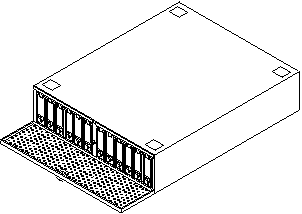
Sun StorEdge A3000 Subsystem
The Sun StorEdge A3000 subsystem is a redundant array of inexpensive disks (RAID) product. It is offered as a companion unit for the following systems:
-
SPARCserver 1000
-
SPARCcenter 2000
-
Sun Enterprise 3x00, 4x00, 5x00, and 6x00
-
Sun Enterprise 450 and 250
It is a high performance rack-mounted disk array controller that features redundant power and cooling by incorporating hot-plug technology to support the unexpected loss of one controller, one fan, or one power supply. Failed disk driver can be hot-plugged without stopping I/O activity to the subsystem.
The controller module, which is installed in the subsystem, supports dual SCSI hosts on a 16-bit SCSI-2 bus. In addition, the unit provides the same SCSI-2 bus interface for up to five differential drive trays in the expansion cabinet.
There are two SCSI controllers inside the controller module that use five independent drive channels to manage data distribution and storage for up to thirty-five disk drives. The controllers perform system status and fault detection functions as well.
The controller module combines disk array technology with redundant modular components to provide fast data transfer rates, plus reliable, high-volume data retrieval and storage functions across multiple drives. It works with the RAID Manager software, a disk array management program for configuring, monitoring, and troubleshooting the disk array and provides high-performance disk array management services.
As part of this overall disk management system, the controller module supports the following disk array elements and configurations:
-
RAID levels 0 (disk striping), 1 (disk mirroring), 0+1 (disk striping plug disk mirroring), 3 (data and parity are striped across a drive group), and 5 (hot spares)
-
Redundant, dual-active controller configurations
-
Hot swapable components (controllers, fans, and so on)
-
Fast write cache
With RAID 3, data and parity are striped across a drive group. One drive is used for redundancy. All other drives are available for storing user data. Figure 2-12 shows a front view of the Sun StorEdge A3000 subsystem.
Figure 2-12 Front View of the Sun StorEdge A3000 Subsystem
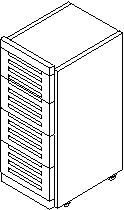
Sun StorEdge A5000 Subsystem
This high-performance and high-availability storage subsystem is designed for the Sun Enterprise 3x00, 4x00, 5x00, and 6x00 family of servers. It replaces the SPARCstorage Array. This subsystem uses 100 Mbit/second Fibre Channel Arbitrated Loop (FC-AL) to create disk arrays that offer two to four times the performance of SCSI-based disk arrays.
The hardware features of this product are:
-
100 Mbit/second PCI and FC-AL host adapters
-
Fully redundant hardware drive chassis for rack and tabletop configurations supporting 1.6-inch and 1-inch disk drives
-
Optional FC-AL hub
The software features of this product are:
-
Volume manager with RAID support
-
I/O driver for the FC-AL host adapter
-
Solstice SyMON and SNMP support
-
Management GUI
This subsystem can store up to 112 Gbytes of information (using 1.6-inch disk drives) or 88 Gbytes of information (using 1-inch disk drives). You can attach up to four disk enclosures using one host adapter. The components in the enclosure are redundant and can be replaced while the subsystem is operating.
Figure 2-13 shows a front view of the array.
Figure 2-13 Front View of the Sun StorEdge A5000 Subsystem
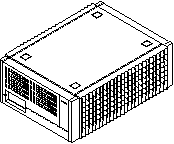
Sun StorEdge A7000 Intelligent Storage Server
The Sun StorEdge A7000 Intelligent Storage Server is a mainframe-class disk array system containing nearly 3 Terrabytes of disk storage. It is designed for the Sun Enterprise 6000 or 6500 data center system.The system contains Symmetric Multiprocessor (SMP) nodes as storage processors. The DataShare software, which runs on this disk array, permits both mainframe and open systems' hosts to directly share the data on the same data volume.
Hardware features of this disk array include fully redundant hardware controllers, cache, hot-pluggable disks, fans, power, and power cords.
Software features include configurable RAID levels, self-diagnostics, health-monitoring, environmental-monitoring, and performance-monitoring.
Serviceablity features include automatic "phone home" and problem reporting supports by on-line diagnostics and repair capability.
Sun StorEdge MultiPack
The Sun StorEdge MultiPack enclosure, which is Fast Wide SCSI, can adapt to 50-pin or narrow hosts. It is self-terminating but it can be chained with units that require external termination.
The Sun StorEdge MultiPack uses single connector disks and it is hot plugable. The enclosure can either contain from two to six 1.5-inch disk drives or from two to twelve 1-inch disk drives. To accommodate from two to twelve 1-inch disk drives you must use an SBus SCSI host adapter.
This unit is an excellent RAID solution for desktop servers when you use the unit with Sun StorEdge Volume Manager or Solstice DiskSuite. You can also use the Sun StorEdge MultiPack with the Netra NFS server for fast and reliable network attached storage.
Figure 2-14shows a front view of the Sun StorEdge MultiPack
Figure 2-14 Front View of the Sun StorEdge MultiPack

Sun StorEdge UniPack
The disk model of the Sun StorEdge UniPack enclosure (Figure 2-15) contains a self terminating hard disk drive. Models containing a tape drive or a CD-ROM drive are also available. The unit is Fast Wide SCSI.
This expansion unit can be used with the following desktop server systems: SPARCstation 5 system, SPARCstation 10 system, SPARCstation 20 system, Sun Enterprise 1 system, Sun Enterprise 2 system.
This unit can be a very good RAID solution for desktop servers when used with Sun StorEdge Volume Manager or Solstice DiskSuite. You can also use this unit with the Netra NFS server for fast and reliable network attached storage.
Figure 2-15shows a front view of the unit.
Figure 2-15 Sun StorEdge UniPack

- © 2010, Oracle Corporation and/or its affiliates
